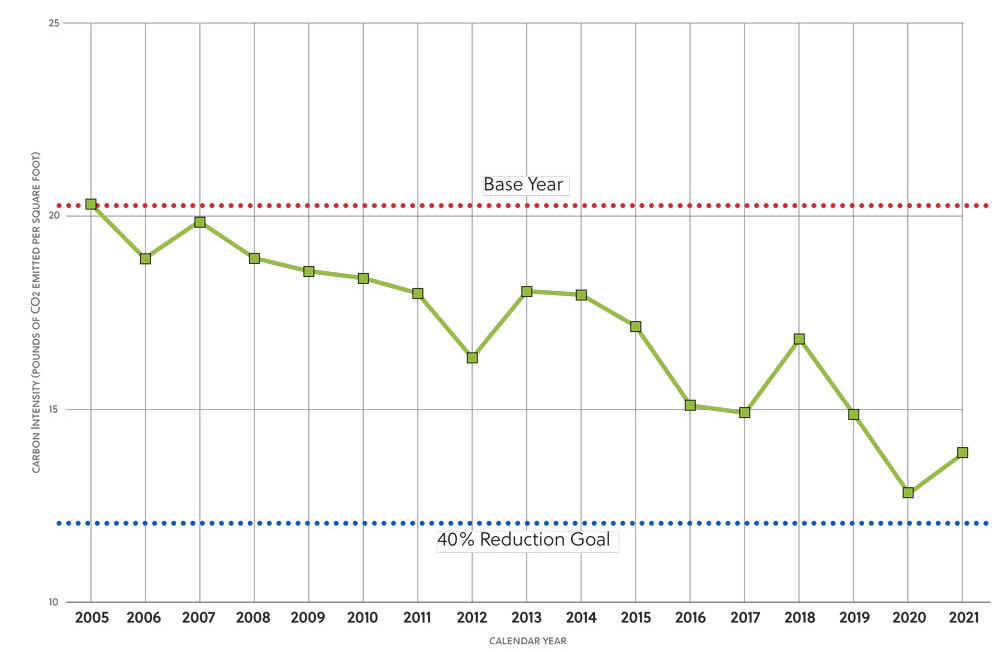NYC Carbon Challenge

Committed to Our City
Since 2005, Fordham has reduced its carbon emissions intensity by 31.77% and its energy consumption by 22.6%.
Launched in 2007, the NYC Carbon Challenge is a voluntary leadership program for universities, hospitals, hotels, commercial offices, and multifamily buildings to achieve reductions in their building-based greenhouse gas (GHG) emissions by 2030. To date, more than 125 of the largest organizations in New York City—including 18 leading institutions of higher education—have pledged to achieve these goals.
Fordham University was a founding signatory to the NYC Carbon Challenge when it debuted in 2007, initially committing to reducing its greenhouse gas emissions by 30%. In the fall of 2017, the University extended its commitment to the challenge by pledging a 40% reduction by 2030.
Altogether, NYC Carbon Challenge participants have cut their annual emissions by more than 600,000 metric tons of carbon, and by the end of the program, current participants are projected to reduce citywide emissions by nearly 1.5 million metric tons of carbon dioxide equivalent—the equivalent of taking more than 300,000 cars off the roads.
Roadmap to Reduced Emissions
Fordham began its plan to reduce greenhouse gas emissions in 2008 when it commissioned a master plan, which involved energy audits of major facilities as well as identifying strategies, through fuel switching, which could reduce greenhouse gases.
There has been a consistent decrease in carbon intensity across Fordham’s campuses since 2005. One of the largest impacts occurred in 2010, when the boilers at Rose Hill were converted to natural gas, which is about 50% cleaner. Reductions have also been realized by equipment replacement and converting fluorescent lights to LED.
Fordham’s energy usage in 2020 and the prospective energy projects planned for the near future indicate that Fordham’s 25-year reduction is on track to reach the goal of a 40% reduction.
Demand Response
Fordham University has enrolled in Con Edison’s Demand Response incentive program. By doing so, Fordham has committed to reducing its energy demand during peak load events caused by higher-than-average temperatures, while also receiving incentives for each kWh reduced during such peak load events. These demand response incentives are then added
to the University’s fund for use in Energy Efficiency strategies and projects.
Renewable Energy Credits
Fordham University has purchased 12.4 million kWh in Renewable Energy Credits (RECs) over the calendar years since 2016. The purchase of these RECs from off-site energy production may be used to offset consumption of electricity from the grid.
Major Projects
In addition to the conversion of boilers to natural gas, Fordham has completed several major projects:
- The design and construction of Campbell, Salice, and Conley residence halls to achieve LEED Gold.
- Ongoing conversion of the vehicles fleet to electric vehicles.
- The conversion of all lighting to LEDs.
- A retro commissioning survey and implementation for buildings greater than 25,000 square feet.
- New energy audits on all buildings greater than 25,000 square feet.
- The redevelopment of the Gabelli School of Business (Rose Hill) and the new Gabelli School of Business at Lincoln Center, as well as the construction of a new Law School building and residential complex at the Lincoln Center campus, at LEED Silver standards.
- The installation of a 250-kilowatt photovoltaic energy generation system (solar panels) at Walsh Family Library.
- The installation of a 963-kilowatt solar array atop the five-story parking garage at Fordham’s Rose Hill campus, the largest consumer of locally installed solar capacity of any institution of higher education in New York City. Learn more about our solar projects.
- The University has begun drawing renewable energy from off-site sources, including the largest solar-power system in New York City to date, through a 20-year agreement with the solar developer EnterSolar to purchase electricity generated at a 10-acre, 9,000-solar-panel installation just east of the Arthur Kill waterway in Staten Island, generating 2.6 megawatts of solar power annually, which will be credited to Fordham’s energy usage.
- Learn more about our solar projects.